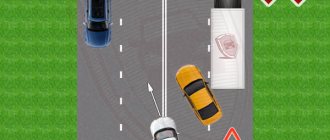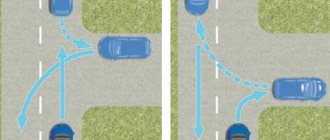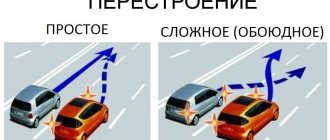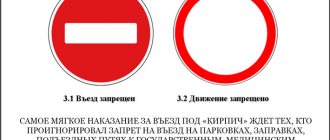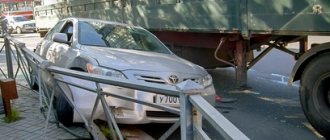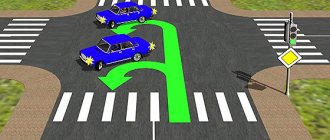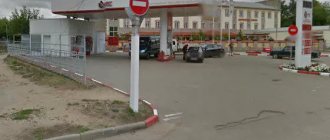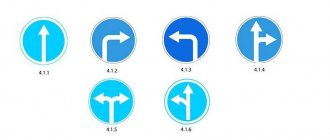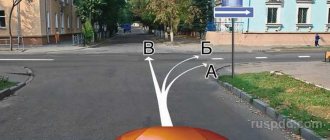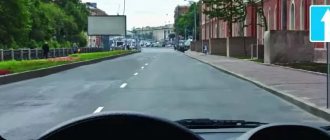“What were you fined for? I drove onto a brick!” - such or similar dialogues can often be heard from drivers, especially if they do not have much driving experience. And everything seems to be obvious: there is a “Brick” sign, it prohibits entry into the territory it is closing, and violation of this requirement leads to a fine.
The greater the surprise of motorists when it turns out that in some conditions they are fined for a relatively small amount of 500 rubles for this sign, and in others they are deprived of their rights. Moreover, there are cases when entry under the “Brick” is possible without any sanctions at all, and will not constitute a violation. We’ll talk about all the details of driving under sign 3.1 “No Entry” in this article.
- Is it possible to pass by public transport?
- When is it installed?
What does the “Brick” sign mean in the traffic rules?
Let’s say right away that “Brick” is an unofficial, one might say popular name for sign 3.1, which is correctly called “No Entry”. However, this colloquial form has become so firmly established in everyday life that it is easily used at all levels - from drivers to traffic police officers and/or judges.
And yet, according to the rules:
Sign 3.1 “Entry prohibited” - prohibits the entry of any vehicle in the direction blocked by this road sign.
Some of the difficulties are already concentrated in this formulation. Are the concepts of “entry” and “travel” different? Why is it stated that the sign applies to all vehicles, if previously it was said that it was possible to drive under the sign with impunity? We'll tell you about all this in due time. For now, let's return to the sign itself.
What does road sign 3.1 “No Entry” look like?
“No Entry” is a round red prohibitory sign with a white rectangle horizontally located in the center of the sign. Actually, this rectangle became the reason to call the sign “Brick”.
See the picture of the sign below.
Exclusion brick sign
Like most road signs, the “No Entry” sign also has exceptions. True, the range of its exceptions is not very diverse - in fact, its effect does not apply only to vehicles transporting people along established routes (drivers of buses/trolleybuses/trams and similar vehicles can relax).
In other words, even the tenant of the house, at the entrance to whose territory a sign 3.1 is installed, should not escape a penalty in case of violation of the ban on entry established by the “brick”.
Of course, there are other exceptions, but they are of a private nature. Often, various organizations place a “No entry” sign at their gates, in addition to hanging a clarifying sign. For example, “brick” with a postscript, “except for bank cars.” It is logical that only the bank’s vehicle – a collection vehicle, for example – will have the right to enter the bank’s territory.
How is it different from a “No Traffic” sign?
Probably, when talking about differences, they do not mean external manifestations, but just in case, let us remind you what these signs look like next to each other:
On the left in the photo there is a “No Entry” sign, on the right there is a “No Traffic” sign.
But the main thing is the essence of the legal differences. You can often find information that “Brick” prohibits travel in one specific direction, and sign 3.2 blocks traffic in both. On the one hand, this is true, but on the other hand, is adjusting the oncoming flow of much importance for the driver in ordinary practice?
Still, more detailed differences are concentrated in the exceptions that give the right to pass under this sign. We will talk more about the “Brick” later, and we will talk about sign 3.2 in detail later in this article.
Difference from sign 3.2 “No movement”
As for the main difference from the white round sign with a red border and serial number 3.2, it lies in fewer restrictions. Thus, 3.2 prohibits the movement of any type of transport, while 3.4 allows passage:
- residents of apartment buildings;
- drivers with disabilities in vehicles with appropriate designations;
- special equipment;
- employees of enterprises located in this territory;
- postal machines;
- city transport.
Exceptions, in which cases and who can go under the “Brick”
Let's move on to the most interesting part - who can freely drive under the "Brick"? More precisely, under what conditions will entry under this sign not constitute a violation.
Is it possible to pass by public transport?
Unfortunately, there are not many exceptions, and most of them apply only to route transport engaged in the transportation of passengers:
Public transport may be allowed to enter “Brick” if it follows from its accompanying documents that the area limited by sign 3.1 is included in its permanent route. Passenger taxis do not belong to this category.
Special plates
Other exceptions are possible if they are expressly indicated on the sign below the sign. For example, “except for clients (such and such, etc. Of course, the fact of belonging to the category of exceptions must be documented.
Urgent necessity
Article 2.7 of the Code of Administrative Offenses of the Russian Federation establishes that events committed in conditions of extreme necessity cannot be recognized as an administrative offense.
On the one hand, this means that “if you really need it, then you can,” but on the other hand, it is almost impossible to prove extreme necessity without involving a lawyer.
Common mistakes
It is with the incorrect interpretation of exceptions that violations are most often associated. It is erroneously believed that the adjacent territory, limited by the “Brick”, allows entry to residents. Or employees of enterprises whose nearby territory is limited to entry by sign 3.1. It's a delusion .
If the situation does not fall under one of the above exceptions, driving under the sign is prohibited. This will be a violation, regardless of place of residence or work.
What are the differences between the “No Entry” and “No Traffic” signs?
Road signs are important elements on the road that are responsible for safety and serve as indicators for motorists and pedestrians. Despite this, some drivers are accustomed to not noticing them while driving. These are the ones who then complain about too high fines and try to prove their innocence. However, there are also motorists who simply cannot remember the designation of some signs, since they very rarely come across them on the way.
Motorists often confuse two roughly similar signs - “Entry prohibited” and “Traffic prohibited.” If you nevertheless study the details of each, you can understand that there is a colossal difference between them and almost no similarities. Accordingly, they must also be executed according to more than one scenario.
Motorists are familiar with the bricks on a red background, which are placed in public places where vehicles are not allowed to pass. This is a sign that is designated in the traffic rules as 3.1 “Entry prohibited.” Along with this sign, an additional sign may be installed, which indicates who is still allowed to pass and at what time. This also includes situations where entry into the territory is prohibited during certain hours or days of the week. If a motorist violates the requirement established by a road sign, he is subject to a fine of 500 rubles.
If we look at another sign, “No Traffic,” you will notice that there are no exceptions to the rules at all. Let us remind you that in the Traffic Rules it is designated as 3.2. You cannot drive a car beyond this sign at any time of the day or day of the week. However, some clarifications are still provided. For example, motorists who live in nearby houses, postmen, disabled people, and employees of organizations that are nearby can move behind this sign. Note that if we are talking about a disabled person, then the vehicle must have a corresponding sticker.
But what will happen to an ordinary motorist who decides to drive past this sign and violate the Traffic Rules? In fact, the punishment even here is not so severe. As a rule, the inspector issues a fine of 500 rubles for such actions. Another important rule is that both signs do not apply to buses, trams, and trolleybuses that transport passengers along a specific route. As a rule, sign 3.1 is installed at road intersections where one direction provides for one-way traffic. In addition, the symbol can be used at the exit of gas stations or in parking lots near large shopping centers. Sign 3.2 imposes restrictions only on the movement of vehicles within the territory. Both signs are prohibitive.
Bottom line . There are 2 signs in the traffic rules that are often confused by motorists - 3.1 and 3.2. They both prohibit the passage of vehicles, but provide their own exceptions.
What is the penalty for driving under the “Brick” sign?
Sanctions for violation are different and directly depend on the place and method of installation of the “Brick”, as well as on the signs accompanying it. Therefore, first we will talk about situations in which sign 3.1 may appear.
When is it installed?
The most common cases of installing a prohibition sign 3.1:
- Restrictions on entry into any territory (for example, into a yard). "Brick" can be installed without additional signs.
- By prohibiting entry into lanes allocated for public transport. Must be accompanied by additional markings or signs.
- Prohibiting entry into oncoming traffic. Accompanied by markings and a permit sign indicating an alternative direction in which traffic is permitted.
- For one-way traffic, prohibiting passage against the direction of flow. Signs confirming one-way traffic are installed at the same time as Brick.
In addition, there is a penalty for repeated violations, but it is not applicable in all cases.
Fine for driving under "Brick"
In accordance with the place and meaning of the sign, the penalties vary:
| Situation | Article of the Code of Administrative Offenses of the Russian Federation | What will happen? |
| Entry under the sign (without oncoming traffic and other conditions listed below) | Part 1 Article 12.16 | From a warning to a fine of 500 rubles. |
| Entering the public transport lane | art.12.17 | The fine is 1,500 rubles, and for Moscow and St. Petersburg – 3,000 rubles. |
| Violation of an oncoming sign | Art.12.15 | Maximum penalty: a fine of 5,000 rubles or deprivation of rights for 4–6 months. |
| Exit to one-way traffic under "Brick" | Part 3 Article 12.16 | A fine of 5,000 rubles or deprivation of driver's license for 4 to 6 months. |
| Repeatedly entering the oncoming lane | Part 3.1 Article 12.16 | If caught by cameras - a fine of 5,000 rubles. When drawing up a traffic police resolution - deprivation of rights for up to 1 year. |
Is it possible to pay with a discount?
Repeated entry into oncoming traffic (Part 3.1, Article 12.16 of the Code of Administrative Offenses of the Russian Federation) is not subject to a 50% payment. The rest can be paid at a discount if repaid within 20 days. Reasons: Part 1.3. Article 32.2 of the Code of Administrative Offences.
Is deprivation of rights possible?
Yes, and this has already been said above. Let us repeat that deprivation of rights from four months to six months is possible in the following cases:
- Driving under “Brick” into oncoming traffic.
- Pass under a sign on a one-way road in the opposite direction to the permitted one.
- Repeated violation related to driving into oncoming traffic.
Let us remind you that deprivation of rights is the maximum possible punishment, which can be replaced by a fine.
Driveway under brick
What is the fine for driving on the side of the road in 2021?
The main problem that causes controversy and deprivation of rights for a brick is the lack of understanding among drivers under what circumstances administrative responsibility arises and for what.
Few people know that it is necessary to distinguish between situations when the only thing the driver did was not comply with the requirements prescribed by the road sign, and all the others.
Find out all the details by phone: According to Article 12.16 of the Code of Administrative Offenses of the Russian Federation, driving under the “brick” sign may be associated with the following actions:
- position of the sign on the roadway;
- the procedure for installing the sign relative to the roadway and the distance at which it should be located from certain objects;
- other rules for installing a sign.
Having a problem?
Call a car lawyer
Who can be fined for a “No Trespassing” sign?
All types of offenses can be recorded by traffic police officers. Some passages to "Brick" can be installed using automatic control devices (cameras). Wherein:
- A traffic police officer has the right to draw up a resolution and record an offense, however, deprivation of the right to drive a vehicle is solely within the powers of the court.
- If a violation of sign 3.1 is detected by cameras, only a fine can be applied .
A fine and deprivation of rights are alternative punishments, and under the articles in question should not be applied simultaneously. However, in addition to non-compliance with the “No Entry” sign, other traffic rules may be violated at the same time, then sanctions can be applied in aggregate.
What is the fine?
Any violation of the restrictive actions of the sign is punishable by a fine, the amount of which varies depending on the situation:
- Driving to an area adjacent to the highway, for example, a parking lot or gas station. Of course, this cannot be called the main road, but the traffic flow here is regulated with the help of road markings and installed signs. The monetary penalty in this case is 500 rubles.
- Following in the oncoming lane is punishable by an even larger fine, up to 5,000.
Considering the possibility of a street accident causing injury to passengers, the inspector has the right to deprive the offender of his driver’s license for as long as six months. Therefore, before quickly passing through a prohibited area, you should think about the threatening fine and consequences.
For example, novice drivers and residents of other regions are equally likely to be punished with a fine of 500 rubles, since ignorance of the area does not exempt them from the need to know the rules and take into account the actions of signs.
Driving into the oncoming lane implies a larger penalty, expressed as a penalty of 5,000 rubles. But perhaps the inspector will take into account the difficult road situation and such a violation could result in the confiscation of a driver’s license for 6 months.
Any violation does not pass without a trace. Such repeated obstruction of oncoming vehicles will be considered a malicious violation. Penalties will be just as severe. The minimum penalty will be 5,000 rubles, the maximum will be deprivation of a driver’s license for 12 months.
Being in the zone of passenger transport in areas specially designated for it also fits under the articles of the law. Even a driver who accidentally drives here will be subject to a monetary penalty, the amount of which reaches one and a half thousand rubles, however, without revocation of his license.
The above situations are only acceptable for ordinary cities and towns. Federal megacities raise the fine by approximately two times. Driving along prohibited Moscow streets or lines in St. Petersburg is punishable by three thousand rubles.
Grounds for appealing entry under a “No Entry” sign
Any erroneous decision can be challenged. The reasons for this may include the following factors:
- The driver is one of the exceptions, whose passage under the “Brick” is not a violation.
- As a special case of the previous one, the sign under the sign gave the driver the right of passage, but this fact was not taken into account when drawing up the resolution.
- Procedural norms were violated when recording a violation.
- The sign was installed with violations and cannot be considered valid.
The final point is the most difficult to prove. Violation of norms F3 No. 196 and/or GOST 52289-2004 must be substantiated. The claims are justified. It is almost impossible for an unprepared driver to do this without the help of a car lawyer. In principle, this applies to other points as well.
What does the “brick” sign mean and what does it look like?
The seemingly unpretentious road sign is called “entry prohibited” in the traffic rules, and motorists have already nicknamed it “brick.” It looks like a red circle, inside it there is a white rectangle right in the center in a horizontal position. It is this figure that is similar to a brick, hence the name of the sign.
A road sign prohibits the passage of a car on a specific section of the road in one direction, that is, where it is located. However, the rule does not apply to all drivers; if evidence is presented, namely documents confirming the right to drive a vehicle on this route, punishment can be easily avoided.
It is often installed near roads where traffic is one-way. This is done in order to reduce the risk of an accident, so you should not break this rule; an emergency situation may arise, followed by bad consequences.
Area of operation of the “No Entry” sign
In the current traffic rules there is no precisely established footage of the validity of sign 3.1. The area of his responsibility can be deduced using the accompanying rules. The main ones:
- Between intersections.
- The entire length of the one-way road is in the opposite direction.
- Throughout the entire isolated territory, at the entrance to which a “Brick” is installed.
The effect of the sign begins immediately after the place where it is installed, unless otherwise clearly indicated on the accompanying plate. Thus, moving behind the sign is prohibited, and there is no permissible number of meters that can be driven under the sign .
Finally, we’ll tell you how to consult with a lawyer for free about driving under the “Brick” or other issues.
For a free first consultation, simply formulate and post your question using the form below. Next, the system will determine the most suitable lawyer (by specialty and geography) and transfer the request to him. A response will be formulated and sent.
Further, if the parties decide to cooperate, our system will remove itself from the process, and the car lawyer and the client will continue to communicate directly with each other.
Coverage area
The “brick” is installed:
- on roads that have a special lane for public transport, which makes it possible to limit the movement of other cars in the appropriate direction along a certain section;
- to indicate the direction of movement (entry/exit) in parking lots, rest areas on highways, gas stations and other areas, which helps to eliminate traffic difficulties and prevent accidents;
- to restrict entry to a certain section of the road.
The road sign “Entry prohibited” must be installed on the basis of legal requirements in accordance with the decision of the authorized body of the State Traffic Inspectorate.
The sign is mounted directly before an intersection, a U-turn, a driveway into a yard, etc. At the same time, the distance from the sign to the area covered by its action must be maintained. In a populated area, the distance is 25 m, while the sign is installed at a height of 2-4 m, outside it the range is 50 m, with a plate height of 1.5 to 3 m.
The distance from the roadway is at least 0.5 m. When installing a road sign, its visibility (at least 100 m), accessibility to the eye (should not be obscured by trees, shields, buildings and other obstacles) is taken into account.
What to do if your car has been towed - where to call the driver?
